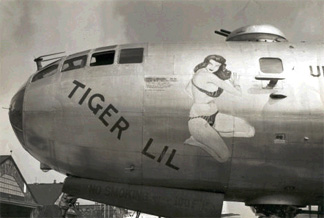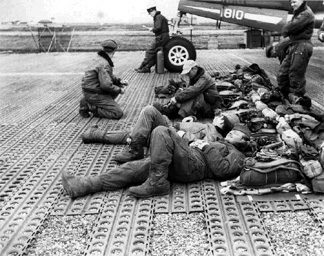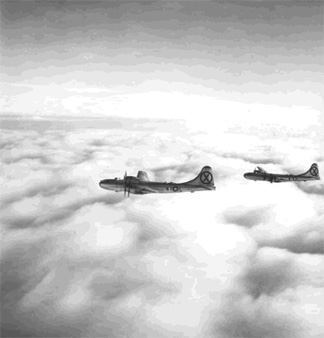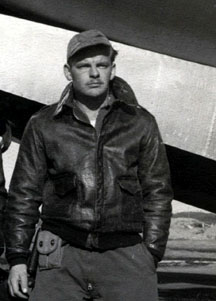William F. (Bill) Welch 31st and 91st SRS
|
|||||||||||||||
|
What I remember about the crew of RB-29 #441810,
shot down in 1952 — Part 2. Our crew returned to the States in late April, 1951 as the first to be rotated. We were scheduled to be assigned to the 5th Recon wing at Travis AFB CA. That was fine with me, my home-town was forty miles to the west, in Petaluma. When we got back from a thirty day leave in May we learned our orders had been changed to the 111th Recon Wing at Spokane, Washington. When we got to Spokane, we learned several interesting things: 1) The Wing Commander, Col. Edward D. Edwards, had (as a LtCol) been the Squadron Commander of the 31st and 91st Recon. 2) The 111th had absolutely no airplanes. 3) The 111th was a Pennsylvania Air National Guard unit recently activated, and previously a Light Bomb Group equipped with B-26s. Their B-26s had been taken away and sent to Korea. 4) Col Edwards had learned that some of his old 91st crews were back and had them sent to Spokane. |
|||||||||||||||
| We were soon joined by another 91st crew, (of the famous “Tiger Lil” #4000) and two returning crews from the 19th Bomb Group of Guam and Okinawa. The four experienced crews would train the 111th as a recon wing. Each of the other three crews were assigned to different squadrons as lead/standboard crews and our crew was made Wing Standardization Board crew.
During the rest of 1951 we scrounged RB-29s from units that had converted to B-36s and trained the 111th National Guard crews in B-29s. We also got a few crews from the Randolph AFB Crew Training Center. |
 |
||||||||||||||
|
This plane and #929 (barely visible under nose wheel hatch in background) were the only two RB-29s in commission and flying missions at the time. These were also the same two planes referred to in Earl Myers’ story of the Christmas parachute drops on the front line. |
|||||||||||||||
| Finally, in late 1951 we declared the first crew “Combat Ready” and they were alerted for shipment to the 91st Recon in Japan. This was the crew that ultimately was shot down in 1952. I knew all of them personally, we had trained them and flown with them. Maj. Busch, the A/C, was (I believe) from the PennANG. In fact I think he may have been the Operations Officer. Others, such as Msgt Homer had flown with us. Homer was our flight engineer for several months. I had known Danny Pillsbury, the photographer, on Okinawa. Pillsbury was in the 31st Recon when I got there in 1949 and he went back to the States for discharge shortly after. When the war started he re-enlisted and ended up at the 111th. As I recall, Danny volunteered to replace another photographer because he wanted to go back to the Far East. I have a feeling that Lt. Jim Scully had been in the 91st also, but my memory is a little hazy there. I believe that the majority of the crew had been with the PennANG.
I got discharged at Fairchild AFB (it had been named that while I was there) in Spokane in Feb. 1952. I went home to California, but after a month re-enlisted at Hamilton AFB. In late June of 1952, I got a letter from a friend in the 111th telling me about the crew that had been shot down. The friend mentioned that they had been flying 810, so I knew it was probably the Soviets that had done it. According to my friend, a search had been made and some empty life rafts spotted, but that was all. Although I never went back on flying status, (Col Edwards tried to recruit me as a refueling boom operator at March AFB in 1957 (I passed on that). I was remotely involved in many “Ferret” flights in the years after. I spent twelve years in AF Security Service, ten years of it in Europe - England, Scotland, Germany, and Crete. I had access to classified reports concerning “incidents” and shoot-downs and was aware of some of the actions of the 91st Recon. That’s what I remember about those times. Although my memory may be a little hazy on some things, like people’s names, the events are extremely clear. As I sat here writing this, it suddenly occurred to me that it was fifty years ago - almost to the day - that I stood on the flight line at Johnson AFB and watched one of our planes circle the field at a low altitude. The two left engines had feathered props, and a huge V shaped chunk was torn out of the trailing edge of the left wing. “They’re going to bail the crew out,” I thought. “A B-29 won’t fly with two engines out on one side. How the hell did they get it back?” But then they made an approach and lowered the gear and flaps. As they neared the runway on final approach, I heard someone yell, “Damn! They’re gonna make it!” No sooner had he said it, than the airplane seemed to stagger and then fell off on the left wing. In what seemed like slow motion it rolled about ninety degrees and hit the ground just off the end of the runway. A huge cloud of smoke erupted as crash crews raced to put out the fire. The entire front of the plane was rolled up in a ball, but the aft section of the fuselage had broken off just behind the wing and ridden up over the wreckage. |
|||||||||||||||
|
Miscellaneous Missions, Projects, and Experiments. In the early days of the Korean War, it was soon apparent that aeronautical charts were woefully inadequate. So, add some additional missions for the 91st. We would map the entire Korean Peninsula from the 38th parallel to the northern border with Manchuria. The area south of the 38th would be done by a detachment of the 3rd Photo Mapping Squadron, based at Clark AFB, Philippines. When the lone airplane arrived from the Philippines to help us, we couldn’t believe it. A B-17 - Complete with an upper forward gun-turret, tail guns, and waist guns all in place. I doubt if there are that many people who know that at least one B-17 flew combat missions in Korea. |
|||||||||||||||
 |
|||||||||||||||
| Normally, our squadron flew at least two sorties a day: One up the west coast of Korea and one up the east coast. We photographed rail yards, airfields, and other military targets. After a while, I think the Korean AA gunners got wise. They knew that over Pyongyang, for example, there would be an RB-29 coming over at around eleven-thirty in the morning, at 12,000 feet. Every day. The west coast run had the most AA, at Kimpo, Seoul, Pyongyang was especially bad, and on up to Sinanju. |
|||||||||||||||
|
With preflight complete, Bill Welch, foreground, relaxes with crewmates while waiting for a boarding call. |
|||||||||||||||
| The east coast was a little easier, with really bad flak at Wonsan, but not much else. So, in addition to these two sorties every day we would now send an additional plane up for photo-mapping. As always, the 91st did a great job, and in a matter of weeks the entire country had been mapped. |
|||||||||||||||
| One of the tasks our crew was assigned, in the fall of 1950, was night photography. This was done by dropping photo-flash bombs, each containing 65 pounds of powdered magnesium. The camera used was a K-19, specifically designed for night operation. A photo-electric cell pointed out the bottom of the airplane picked up the flash when a bomb went off and tripped the camera. The bomb had to go off at a precise location in relation to the airplane: one-third the altitude of the plane, and just out of the cone of coverage of the camera. If it was too far behind, the pictures would be too dark. If it was too close, there would be a huge flare in the photo. To control the | |||||||||||||||
 |
|||||||||||||||
|
|
|||||||||||||||
|
trajectory of the bomb, we placed small metal plates, called trail plates, on the rear of the fins of the bomb. By varying the width of those plates, the bomb could be slowed to the proper position. The altitude of the burst was controlled by a timer fuse in the nose of the bomb.
We flew a couple of practice runs over Japan to get the procedures down. I think we probably scared the tofu out of lot of Japanese, blasting them with huge flashbulbs in the sky. We flew several night missions over Korea, and then no more. I don’t know whether the results didn’t meet their requirements, or what. I do know we got good pictures. |
|||||||||||||||
| Another interesting thing we were tasked with was radio transmission of photos while still over the target area. A captain from Wright-Patterson flew with us to test the theory. The idea was, a photo would be taken of a target using single sheets of film. The film was then developed in an on-board darkbag holding the chemicals. Then, after a very quick drying of the film it was passed to the radio operator’s position where a modified wire-photo machine had been set up. The film would be wrapped around the drum and transmitted back to wherever by radio instead of telephone line. The only trouble was, we had to use high frequency radio, VHF wouldn’t carry far enough. And HF was subject to static, which caused very funny looking pictures to be produced. The captain disappeared, presumably back to Wright-Pat. And we didn’t hear any more about it.
Oh well. Seemed like a good idea at the time. |
 |
||||||||||||||
|
Photo/Gunner, RB-29 |
|||||||||||||||
|
or Home - Contact Us - Cold War Hist. - 91st SRS Hist. - Stardust 40 Mission Story |
|||||||||||||||